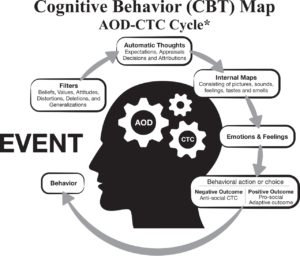Recovery Themes and Ideas*
Before I do that, we cannot go any further without covering what I call recovery themes. Take some time to consider which of these makes the most sense to you in your personal experience. Which of these might you adopt as your own? Which of these would you want your children or grandchildren to become aware of or use? Which could be helpful for clients? Granted, not all of these will be true 100% of the time. Take what you can and leave the rest. All the clients liked at least one of these. Many chose several. Clinicians at other workshops said they are all useful in some context. These themes go with the map at the top of the previous post. You can choose more than one.
- Communication is redundant. We are always communicating in all three major Sensory Modalities: visual, auditory and Kinesthetic (VAK). We all have our preferred learning and communication styles. These are learned in class or workshops.
- The meaning or quality of the communication is the response that you get. Communication is about getting the intended response from the listener. Is the recovery message clear?
- People respond to their map of reality and not reality itself. These maps have structure or syntax (VAK, KAV, AVK, etc.) Maps can be changed to get desired outcomes. We create our realities. This can be empowering or limiting. Are you V, A or K?
- Requisite variety can help people make changes to get desired outcomes. The more tools or flexibility one has the better his chances of success in recovery. Give the client the tools needed.
- People work perfectly. No one is wrong or broken. It’s simply a matter of finding out ‘how’ they function now so that we can effectively change that to something more useful or desirable. Treatment is about change and helping clients get to their next level.
- People always make the best choice available to them at the time: given their situation (the event), beliefs, values and attitudes. There may be a wealth of better choices that have not been examined. But, the belief system must be changed first as Ellis suggested in his ABC Theory***.
- Every behavior is useful in some context. Even drug use and crime. It is just not appropriate.
- Choice is better than no choice. Treatment is about giving clients more and better choices.
- Anyone can do anything. If one person can do something it is possible to model that behavior or skill and teach it to anyone else. Of course, we cannot expect to violate the laws of Physics or nature and expect to be successful. Desired outcomes must be realistic to be achievable.
- People already have all the resources they need to examine and resolve their own issues given the right counseling in a suitable environment. Carl Rogers might fully endorse this theme.
- There is no such thing as failure, only feedback. We learn from our trials and errors.
- Chunking is a way to accomplish any task. If we break goals down we can be successful with anything such as with ‘one day at a time’, a famous AA slogan. (Alcoholics Anonymous)
- Positive intent. All behavior begins with a positive intent. Even substance abuse or crime. Again, we must remember that AOD/CTC could be problematic as well as not be legal.
For those who want more information about these ideas see “Criminal Justice and Addictions Counseling” in the catalog.
*These are based on Major Presuppositions or tenets of the work of Richard Bandler, PhD., and John Grinder, PhD. It is adapted and reproduced here with permission from Tom Dotz, Colorado, where I did a training course. This writer feels that these presuppositions can be adjunct modalities of treatment to effect change with Applied Cognitive Behavior Theories.
